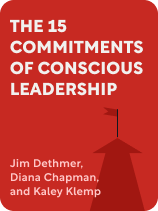

This article is an excerpt from the Shortform book guide to "The 15 Commitments of Conscious Leadership" by Jim Dethmer, Diana Chapman, and Kaley Klemp. Shortform has the world's best summaries and analyses of books you should be reading.
Like this article? Sign up for a free trial here.
What is an abundance mentality? How can you combat a scarcity mindset?
The 15 Commitments of Conscious Leadership says that you must adopt a mindset of abundance if you want to be the best leader for your organization. In other words, believe that there are enough external resources (jobs, money, and so on) to make everyone happy.
Discover how to embrace an abundance mentality below.
Adopt a Mindset of Abundance
Leaders with scarcity mindsets believe that there aren’t enough external resources to go around. Therefore, they believe that instead of collaborating with others, they must greedily compete with and triumph over them to survive and thrive.
(Shortform note: In Daring Greatly, Brené Brown also highlights the negative outcomes of scarcity discussed by the authors, which she classes as narcissistic behaviors (competition and greed) and disengagement (a lack of willingness or ability to connect with others). Brown adds that scarcity causes people to experience shame (the fear that we’re unworthy of connection and belonging). To overcome scarcity, Brown argues that leaders must adopt a mindset of wholeheartedness. Wholeheartedness not only requires you to adopt an abundance mindset, as the authors recommend, but also to practice vulnerability as a means of overcoming shame.)
The authors offer two main recommendations for combating a scarcity mentality and adopting an abundance mentality instead:
Recommendation #1: Meditate on Abundance
The authors explain that practicing an abundance meditation can help you release your scarcity mindset by grounding you in the present moment. They note that we often adopt a scarcity mindset when we focus on either things we lacked in the past or things we might lack in the future. When you use meditation to focus on the present, you realize you have everything you need to feel satisfied, and you experience feelings of abundance.
(Shortform note: Focusing on the present, rather than the past or the future, may do more than help you overcome the scarcity mindset—it may also improve your overall mental health. Some research has linked being present to reduced stress and more emotional stability.)
To practice an abundance meditation, the authors recommend first focusing on what your body’s doing right now—your heartbeat, your breathing, and so on. Next, focus on the fact that your body feels complete—there’s nothing you’re missing. Then, focus on the present moment and acknowledge that there’s no past or future: Only right now exists. Finally, recognize that in this moment, you have more than enough to feel satisfied.
| Staying Focused During Your Abundance Meditation The authors’ abundance meditation involves focusing on four specific things: your bodily sensations, the completeness of your body, the present, and your abundance. If you have a naturally wandering mind, get easily distracted, or aren’t used to practicing focused meditation, the idea of keeping your attention on these specific elements may feel daunting. Here are some tips for retaining focus during a meditation session: Pick the right environment. Meditate somewhere quiet, comfortable, and secluded to avoid distractions and interruptions. Prepare your body. Make sure you’re well-fed and well-rested before meditation so you don’t get distracted by hunger or fatigue. Pay attention to distracting thoughts, then move past them. Trying to ignore distracting thoughts won’t get rid of them—they may even come back stronger. Instead, acknowledge that you’ve had the thought, then let it leave your mind. Don’t interact with the thought any further than this. |
Recommendation #2: Find Solutions That Benefit Everyone
The authors explain that leaders often struggle to develop effective solutions to problems or questions because their scarcity mindset tells them that only one party can triumph. To release this mindset and embrace a mindset of abundance instead, start looking for solutions that please as many people as possible—ideally everyone.
(Shortform note: Although the idea of finding a mutually beneficial solution seems hard to oppose—if everyone wins, who’s left to disagree?—some experts argue against this approach. For instance, negotiation coach Jim Camp asserts that win/win approaches often mean that the more powerful party pushes the other into a less-than-ideal compromise. In Start With No, he posits that a win/win mindset pressures both parties to rush to any agreement rather than doing the haggling necessary to reach the best deal.)

———End of Preview———
Like what you just read? Read the rest of the world's best book summary and analysis of Jim Dethmer, Diana Chapman, and Kaley Klemp's "The 15 Commitments of Conscious Leadership" at Shortform.
Here's what you'll find in our full The 15 Commitments of Conscious Leadership summary:
- Why many leadership models are unsustainable in the long term
- Why leaders must learn to understand and manage their emotions
- The 15 commitments that leaders must uphold to run an effective organization






